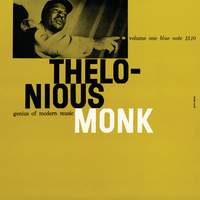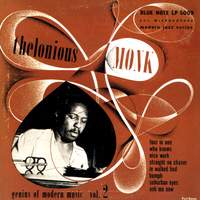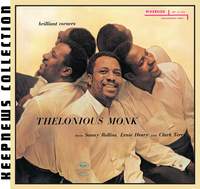Classic Recordings,
Thelonious Monk Trio
Classic Album of the Week
 I’m not entirely sure what constitutes a Classic Album for this column; most likely it should be bona fide masterpieces like Kind of Blue and Love Supreme (both of which I am bound to cover someday, although I’m not sure they need it); but seeing as it’s entirely up to me what I choose each week I’m going to try something a bit less ubiquitous. I’ve been pondering which Thelonious Monk album to choose for a while, but where to start? An obvious choice would be an acknowledged classic like Brilliant Corners, but I’ll leave that for now and instead turn to something that has only been a recent discovery for me: the unassumingly titled Thelonious Monk Trio from 1954.
I’m not entirely sure what constitutes a Classic Album for this column; most likely it should be bona fide masterpieces like Kind of Blue and Love Supreme (both of which I am bound to cover someday, although I’m not sure they need it); but seeing as it’s entirely up to me what I choose each week I’m going to try something a bit less ubiquitous. I’ve been pondering which Thelonious Monk album to choose for a while, but where to start? An obvious choice would be an acknowledged classic like Brilliant Corners, but I’ll leave that for now and instead turn to something that has only been a recent discovery for me: the unassumingly titled Thelonious Monk Trio from 1954.
Recorded during a challenging but productive period for Monk, Trio finds the pianist testing the boundaries of his art, at times almost to breaking point. As a backdrop to this, in August 1951 police had found narcotics in a car that Monk and Bud Powell were in, and they rightly presumed that the drugs belonged to Powell. When asked, Monk refused to testify against his friend, saving Powell from a prison sentence, but this prompted the police to confiscated Monk’s precious New York performance licence, effectively stopping him from playing in any establishment that served alcohol; so aside from a handful of gigs at concert halls like Carnegie Hall, Monk lost his main source of income. Luckily for Monk he had the support of his wife Nelly, who became the main breadwinner, allowing the him the time to develop his music at home, and he was also able to record his music, signing to Prestige in 1952. Compared to the earlier Blue Note recordings these sessions sound somewhat jarring, because as ground-breaking as those first recordings are, they’re still firmly in the bebop style. Thelonious Monk Trio is the sound of Monk testing the boundaries of his art and the trio setting (recorded either with bassists Percy Heath or Gary Mapp, and drummers Art Blakey or Max Roach), adds extra starkness, with Monk taking centre stage and not having to slot his solo in with others. As such we hear him take his experiments in dissonance to new levels, like the clanging chords that open Little Rootie Tootie, which he returns to with a mischievous glee throughout, or the way he almost makes the piano sound out of tune on Monk’s Dream. The various rhythm sections provide sparse yet swinging structures for Monk’s fractured tunes to cling to, and swing.
If you have a passing knowledge of Monk’s music you will recognise plenty of favourites here, many of which appeared on the Blue Note sessions just a few years before in less confrontational form; Bye-ya; Blue Monk; Trinkle Trinkle and Bemsha Swing being stand-outs. To hear Monk’s influence on his contemporaries, just listen to early Cecil Taylor albums like Jazz Advance or Love for Sale, which are chock full of Monk’s angular, erratic lines. I wouldn’t recommend this as a first taste of Monk, but if you want to hear a master in the process of honing his craft, with the support of musicians of the calibre of Max Roach and Art Blakey, it’s fascinating stuff.
Available Formats: MP3, FLAC
Suggested further listening....
Suggested listening....
If you haven't heard the early Blue Note recordings I would definitely recommend starting there, as they serve as the bedrock of any Monk collection, and then move on to Brilliant Corners and then the Trio recordings.
Available Formats: MP3, FLAC, Hi-Res FLAC, Hi-Res+ FLAC
Available Formats: MP3, FLAC
Monk's most fully realised album, the music of the title track was so difficult for the other musicians to grasp that they took over a dozen takes, before ultimately stitching together a composite.
Available Format: CD






